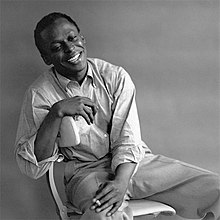Miles Dewey Davis III (May 26, 1926 – September 28, 1991) was an American jazz trumpeter, bandleader, and composer.
Widely considered one of the most influential musicians of the 20th century, Davis was at the forefront of almost every major development in jazz from World War II to the 1990s: he played on various early bebop records and recorded one of the first cool jazz records; he was partially responsible for the development of hard bop and modal jazz, and both jazz-funk and jazz fusion arose from his work with other musicians in the late 1960s and early 1970s; and his final album blended jazz and rap. Many leading jazz musicians made their names in Davis' groups, including: Joe Zawinul, Chick Corea and Herbie Hancock, saxophonists John Coltrane, Julian "Cannonball" Adderley, Gerry Mulligan, Wayne Shorter, George Coleman, pianist Keith Jarrett, and Kenny Garrett, drummer Tony Williams and guitarist John McLaughlin.
As a trumpeter, Davis had a pure, round sound but also an unusual freedom of articulation and pitch. He was known for favoring a low register and for a minimalist playing style, but was also capable of highly complex and technically demanding trumpet work. This said, Davis was never a virtuoso of his instrument, and, on the ground of sheer technique, he was inferior to many prominent trumpet players of his era. He made up for these shortcomings by concentrating on the melodic quality and lyricism of his performances, to the point of becoming known as a specialist in ballads, a province where trumpet players were seldom found, up to that point.
Above all, Davis - at least in his best years - displayed an unparalleled capability of selecting musicians for his groups and of directing them, a strong sense of where he wanted to take his music, and a great tenacity in pursuing his artistic objectives.
To this he added an instinctive ability of self promotion that kept him in the eye of the public and of the musical media most of the time. While he professed disdain for the musical critics, his life, attitudes and style (down to the cars he drove and the stylish dresses he used) helped him in building an iconic status, and eventually made him one of the very few jazz superstars in the rock dominated decades of the 1970s and 80s. He had, however, already achieved stardom at the end of the 1950s, one of the few jazz musicians that was addressed, in print and elsewhere, on a first name only basis.[1]
In the last two decades of his career, when his production was heavily influenced by rock and other styles of popular music, Davis gradually distanced himself from being called a jazz musician, even refusing, after his return in 1980, quite strongly the term "jazz music" (as other musicians had done before him), in favor of terms like "black music".[2] During the same period, most of the jazz audience distanced itself from Davis, sometimes on the ground that his music was no longer jazz, but most often on the grounds of its perceived commercialism.[3] The first decade of the XXI century saw a very favourable critical reevaluation of Davis' so called electric years (1970-1991), often reversing previous unfavorable opinions. Since several of these judgement reversals came on the heels of the release of previously unpublished archive material, very often labeled with superlatives such as "legendary", the neutrality of these new critical appraisals is hard to assess.
On March 13, 2006, recognising his role in the development of rock, Davis was posthumously inducted into the Rock and Roll Hall of Fame. He had already been inducted into the St. Louis Walk of Fame, Big Band and Jazz Hall of Fame, and Down Beat's Jazz Hall of Fame.


